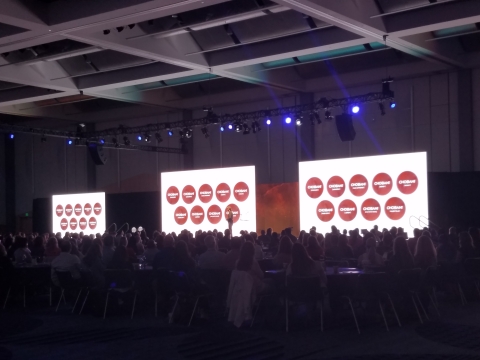Experiential Marketing Summit (EMS) Brought Education to the Mile High City

EMS 2016 took place in Denver May 4-6 at the Colorado Convention Center, and with it, more than 1,300 attendees and 125 exhibitors, an increase from 2015. “As the industry evolves, so does the Experiential Marketing Summit,” said Event Marketer Magazine Group Editor Jessica Heasley. “We continue to focus on the content and the overall experience.”
Both the Pepsi and Chobani keynotes were the topic of conversation with attendees, especially the insights brought by Chobani Chief Marketing Officer Peter McGuinness. “Everything done well can be an experience for your customer, and good experiences build your brand,” McGuinness said.
Chobani makes big investments in marketing, and the company plans to increase the investment in event and experiential marketing in the future. “Our big push is to get our product into the hands of consumers, and events are a great way for us to do that, and do it well,” McGuinness said.
Another popular session was the “Power Panel B to B Dream Team”, assembling some of the brightest marketing stars for a discussion around event and experiential marketing. Included in the panel were Colleen Bisconti, vice president of Global Conferences and Events, IBM; Greg Schneider, marketing director, Global Events Marketing, Dell; Heather Henderson Thomas, senior manager, Strategic Operations, Cisco; Jonas Tornqvist, senior global event manager, Sony Mobile; and Shantel Gascoigne, digital marketing manager, Partner Community Marketing, Microsoft.
Many insights were shared, such as the practice of driving physical experiences from social best engagements and using digital platforms to connect people in a one-on-one engagement that can then transfer to the showfloor.
Another topic of conversation was around using your trade show as a content factory and events as a ‘social accelerator’ to engagement. There also was a debate around access to content, and whether or not open content is the way to go.
Many argued that having event content (such as recorded video lectures and workshops) open to anyone helps build relationships, trust and event longevity. Of course, the topic of engagement did not come without the conversation of data. Many on the panel agreed that data analysis needs to be done in ‘bite sized chunks’ rather than massive aggregation.
The topic of Gen Z was in full discussion mode with the lecture “What College Kids Want, and How to Give It to Them: Gen Z Events with Nestle”. Co-presenters Lauren Parker, experiential marketer manager, Nestle, and Darren Ross, executive vice president, Solutions, Fluent, provided some interesting data around engagement for Gen Z and their digital practices.
Gen Z will skim digital content over multiple devices and are technology savvy. They have technology expectations and want a product to be tied to the experience, including the digital one, and want the experience with the brand to have an impact. They are not looking for ‘finished’ visuals from a brand, but instead want to have visual communications on their terms. Interestingly, for this age group, video consumption is at the top, but Facebook engagement is not that far behind. Pinterest is falling in terms of use in this group as the visuals are too ‘polished’.
PayPal used a very recent employee event to discuss how to use an event to help usher in change. Jamie Sanyal, head of Global Experiential Marketing from PayPal and Whitney Beatty, vice president of creative, PBJS, discussed how their employee event, and the proper execution, helped reduce resistance to PayPal breaking off as a separate company from eBay.
They highlighted how a properly executed event can create an unparalleled sense of unity and can be far more memorable. PayPal used this event to celebrate moving into a new chapter for all employees, and tied the event to employees around the globe with simultaneous celebrations. They provided ‘kits’ for the offices, but allowed personalization by the local office to make the items work within that country, and office, culture.
Even at the end of the last day, many were in attendance for “Viral Strategies for B to B Events”, co-lectured by Elizabeth Thompson, marketing communications specialist at Eaton and Ben Grossman, vice president and strategy director, Jack Morton Woldwide.
Making something modern day ‘viral’ was redefined in this lecture as voluntary through peer-to-peer engagement. However, millions of eyeballs does not equal millions of sales dollars. The newly defined virality equates to effective engagement, not just infective.
Viral strategies need to be targeted, managed, and amplified. And the first start to having a viral campaign is to design assets that are actually sharable. In addition, there should be an active role by the organization to make something viral, and the engagement has to be memorable.
In addition to the education sessions, attendees used other agenda items to connect and learn. “Our attendees are the heads of event marketing for Fortune 1000 companies. Almost 90 percent of them don’t go to another industry conference. So, we’re focused as much on getting attendees together organically - morning yoga, evening dinners - as on engaging them in the 80 breakout sessions,” Heasley said.
Experiential Marketing Summit 2017 will take place May 3-5 at McCormick Place in Chicago, and EVENTtech will take place this year November 14-16 at the Paris Casino in Las Vegas.


Add new comment